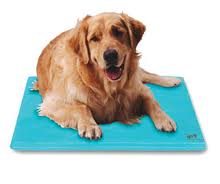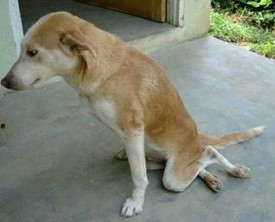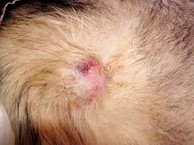Bladder Care
Preventative bladder care plays a critical part in the health of your pet. If you pet has suffered nerve damage to the hindquarters, paralysis or stroke, your pet's bladder must be expressed at least three times a day. Many people may decide to euthanize because the vet implies it is really difficult to do. That is not the case. A bit of practice is all it takes to get proficient in getting all the urine out at a session. Have your vet or vet nurse give you a demonstration first, so that you know the correct pressure to apply. If necessary, the next day go back and express your dogs bladder under supervision of the vet or vet nurse to make sure you have gotten all the urine out.
Paralysed pets are subject to partial urine retention. Often when you find your pets bed wet, it does not mean that it is urinating on its own, but that the bladder has become so full that there is an overflow leakage.
Cystitis or bladder infection is one of the greatest threats to your pet's health. Such infections are very serious and could lead to death if left untreated.
Signs of a Urinary Tract Infection include:
- Dribbling or evidence of urine, such as soaking of the rear quarter and bedding
- Foul odor of urine, and an increased licking of the genital area as infection worsens
- Bloody or dark colored urine. This is a severe symptom and requires immediate veterinary care!
- Depression, loss of appetite, rise in temperature as infection progresses
Treatment of Urinary Tract Infection
Prevention is the best solution. The co operation of your veterinarian in prescribing the best medication, monitoring pH, culturing the urine, and providing instruction on expressing or clearing the bladder of pooled urine is essential for successful nursing care. Urine retained in the bladder can become a medium for bacterial growth.
Proper bedding for your paralysed pet
Confining your pet to an area where there is plenty of soft bedding, when not in its wheelchair is important to keep your pet from dragging itself around as this will help prevent pressure sores. It is also crucial to your pet's health and recovery. If given a choice, most pets will choose a hard, cool surface over a soft, padded area to rest on. This makes your paralysed pet more susceptible to developing pressure sores. We have Canine Cooler pet beds that will keep your pet cool and help prevent pressure sores.

We recommend the Canine Cooler pet waterbed. This bed is ideal for pets that get hot easily and seek out a cold surface to lie on.
Cool surfaces are often hard surfaces; and for a mobility impaired pet, lying on a hard surface makes it more susceptible to pressure sores and hygromas (elbow sores).
Do not allow your pet to lie continually on one side. Turn them over regularly. For pets with forelimb weakness, or rear limb problems, it is sometimes better to prop them up on their abdomen with their front legs extended and hind legs tucked up underneath (sternal recumbency) using rolled up blankets on either side of their body with their head resting on a rolled up towel. For larger dogs, Clark Rubber can supply foam wedges which are great.
Do not allow you pet to drag around the floor unprotected, over any hard surface as this will cause pressure sores. Once established, these sores are difficult to heal.
Never allow your pet to scoot around on its bottom with its rear legs out at a 45 degree angle. This could cause limb deformity or damage to rear limbs and joints.


Bathing for you Pet
Regular bathing will maintain your pet's coat and skin in a healthy condition and prevent sores. Your pet's hindquarters must be gently bathes, at least once daily, with warm water and a soft, clean cloth.
If you pet has an excessive amount of hair, you may want to clip the rear area for sanitary reasons, east of care and to keep the area clean. You can ask your vet clinic if you can purchase a small bottle of Chlorhexidine, which is a anti bacterial wash.
Pressure sores
Pressure sores can be extremely serious and, if not caught in time, can open right down to the bone. Prevention is the best answer. Proper bedding, regular bathing and the use of a pet wheelchair will also help prevent pressure sores.

Your Pet should be checked every day for pressure sores as they can be hidden underneath the hair; be particularly watchful with long-haired pets as the sores can be hidden in the coat. Check your pet's hips and elbows for sores if it has a tendency to lie on one side. If you pet does incur pressure sores, visit your veterinarian immediately. Your veterinarian will advise you on proper care of pressure sores.